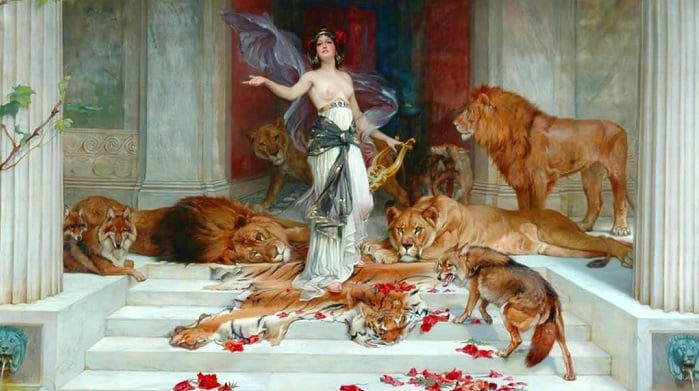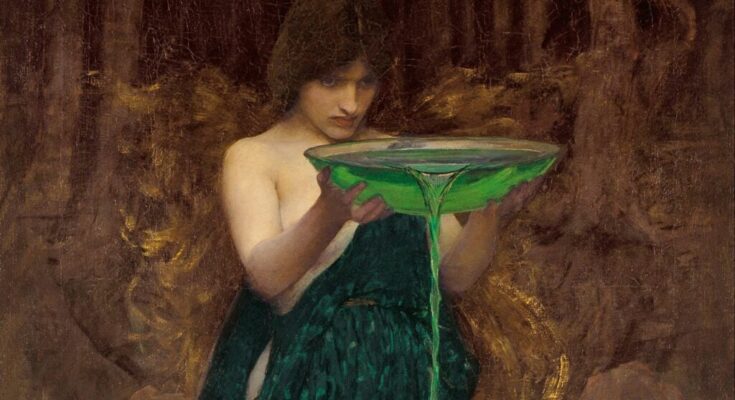
In Homer’s Odyssey, the episode of the witch Circe is one of the most deliciously intriguing of the epic. She is often referred to as the very first witch of Greek mythology and commonly known for the “punishment” she inflicted on sailors who foolishly stumbled upon her island, turning them into pigs.
The character of Circe has been significantly influential on art throughout the centuries, as she is considered the most dynamic and powerful woman in the Odyssey (even though, eventually, she submits to Odysseus). Most recently, in 2018, she was the subject of Madeline Miller’s novel Circe, a feminist retelling of the Odyssey that focuses entirely on Circe’s enthralling history and her struggles.
Circe, however, has also been extensively depicted in art. Throughout time, artists have attempted to capture her exotic, ruthless charm, and witchy nature on canvas. The interesting thing is that each artist visualizes Circe differently in their paintings, but her nature remains quite the same in all depictions. Below are the most compelling paintings depicting the enchantress Circe.
The most compelling paintings depicting Circe the Enchantress of ancient Greek mythology
Paintings by John William Waterhouse: Circe Offering the Cup to Ulysses, Circe Invidiosa, The Sorceress
Waterhouse, one of the pre-Raphaelites, loved painting Circe, so much so that he produced three paintings of her. In all of them there seems to be a common theme: Circe as femme fatale.
In Circe Offering the Cup to Ulysses, Circe is portrayed as a beautiful woman first and foremost, but with a beauty that has a malignant edge to it. The viewer shouldn’t be fooled by her calm appearance, or her kindness as hostess in extending a cup of wine to Odysseus. The pigs at her feet suggest the malice of her nature, and the confidence of her posture points to a woman strong and independent: a witch.
Circe Invidiosa, meaning “Jealous Circe,” reveals this nature a bit more clearly. Here, Waterhouse wasn’t inspired by Homer but by Ovid’s Metamorphoses. It portrays the scene where Circe, jealous that Glaucus picked the nymph Scylla over her, pours a magic tincture in the water where Scylla bathes to transform her into a six-headed monster. Circe’s gaze here is steady and hard, and she doesn’t flinch.

In Waterhouse’s third painting, The Sorceress, Circe is shown in a more ordinary, domestic moment. She sits in her home in Aeaea, most likely on the table where she crafts her potions, pondering. What exactly, the viewer doesn’t know, but she appears deep in thought—so much so that she doesn’t heed the fallen cup and spilled wine in front of her. Waterhouse here depicts Circe’s human, mortal side.
Ulysses and Circe, by Angelica Kauffmann

Kauffman’s painting, as author Madeline Miller suggests, shows Circe as “counselor”. It depicts her in a slightly seductive way, likely offering advice to Odysseus on what course to take. And indeed, she proved to be a major help for him, more so than any other character he encountered—besides telling him to journey to the Underworld to seek advice from prophet Tiresias, she also advised him on how to safely sail past the monsters Scylla and Charybdis.
Circe here is counselor and perhaps part lover part friend, yet still clings to her sorceress identity, glimpsed through the wand she still holds on her left hand.
Circe, by Wright Barker

Circe here is painted by Barker as imposing and grandiose, every inch the stunning goddess she’s meant to be. She appears as hostess, welcoming viewers (are we in the place of sailors?) to her home, standing in a backdrop of wild animals that appear tame at her presence. However, Barker also gives her the quality of an artist, glimpsed in the lyre on her left hand. Although still retaining ancient Greek elements in Circe’s dress and the architecture, this painting is more exotic and oriental.
Circe Pouring Poison into a Vase and Awaiting the Arrival of Ulysses, by Edward Burne-Jones

In Burne-Jones’ painting, beauty and danger uncannily coexist. Circe is shown before a table set for a feast, for Odysseus and his comrades; alone, she doesn’t act the part of gracious hostess. Instead, she is shown bent (almost like a hag, despite her striking beauty) over an ornate vase, with one arm extended and pouring something into it, which from the title we learn is poison.
Here, the sunflowers framing Circe as well as the sea at the back mellow down the image, yet the threat of the witch Circe is mainly conveyed by the wild animals at her feet and the intense expression on her face. One thing can be said for certain: in mythology, Circe is a multifaceted woman, and artists have done a great job bringing all of her “aspects” to life.



